The pilot of an F-16 air force jet that went missing yesterday while taking part in the live-fire drills of the annual Han Kuang exercise has been confirmed dead, after rescuers found body parts and other items on Wufenshan (五分山) in New Taipei City.
The air force’s forensic science unit confirmed that the remains belonged to 31-year-old Major Wu Yen-ting (吳彥霆) of the 12th Tactical Reconnaissance Squadron, the Ministry of National Defense said in a statement last night.
Searchers had found blood-stained pieces of the pilot’s anti-G suit and other clothing, as well as body parts in trees at the crash site, it said.
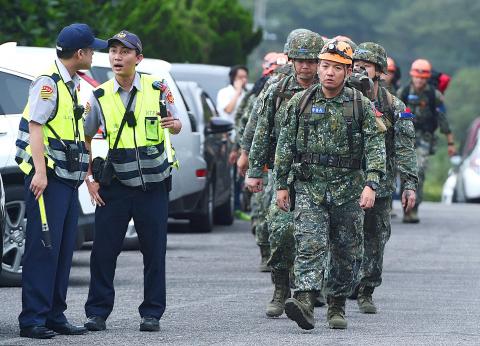
Photo: Liao Chen-huei, Taipei Times
The confirmation of identification came just hours after officers from the 5th Tactical Composite Wing had held an evening press event at the Hualien Air Force Base.
Wu was flying an F-16 with the tail number 6648, which took off from the base at 1:09pm and radar contact was lost at 1:43pm over northern Taiwan, Air Force Command Headquarters had said earlier in the day.
Residents in New Taipei City and Keelung were quoted by local Chinese-language media as saying they heard a loud bang that appeared to come from the mountainous areas around New Taipei City’s Ruifang (瑞芳) and Nuannuan (暖暖) districts.
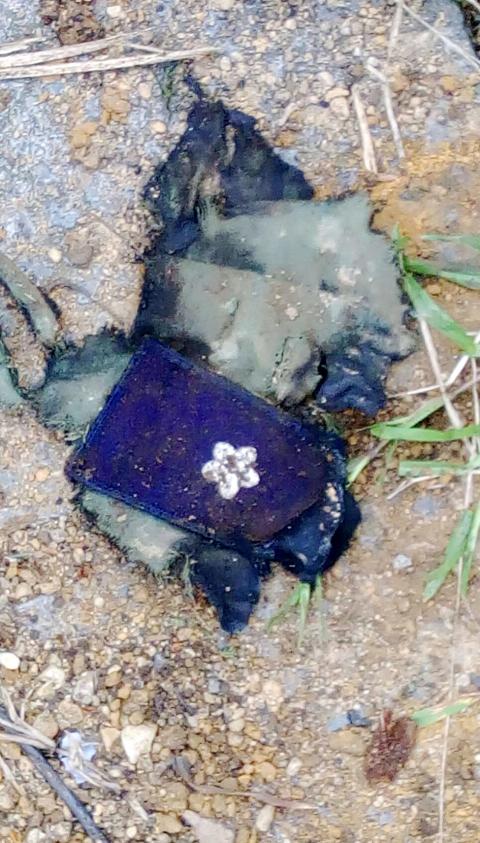
Photo courtesy of New Taipei City Fire Department
The National Airborne Service Corps and firefighters from Keelung, New Taipei City and Yilan County were deployed to help in the search and rescue efforts.
A hiker telephoned the New Taipei City Fire Department at 3:22pm to say he had found the possible wreckage of the jet, the department said.
At 4:18pm firefighters found what appeared to be the crash site on the Wufenshan hiking trail about 3km from the meteorological radar observatory, the department added.
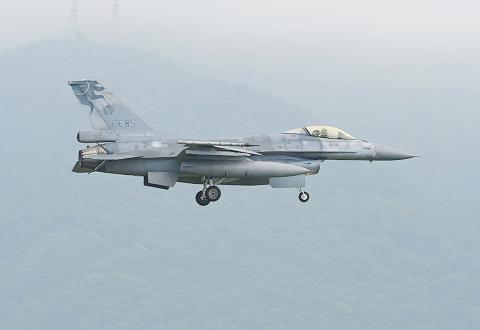
Photo: Yu Tai-lang, Taipei Times
Firefighters found “a substantial quantity” of debris, including a yellow military drag parachute, many toppled trees, skid marks and a 100m long gash in the woods, it said.
About 6pm, rescuers discovered what they suspected to be human remains and pieces of personal equipment, including the pilot’s G-suit and insignia, which were sent for examination by forensic technicians, officers told the Hualien news conference, which was attended by Major General Hsieh Ming-te (謝明德), director of political warfare at the 6th Army Corps.
Military personnel had identified the parachute as a fighter jet’s drag chute from a photograph taken by the search team.
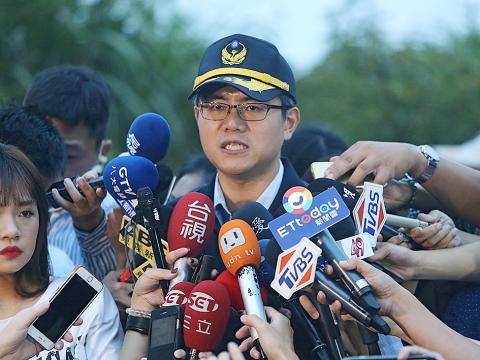
Photo: CNA
Minister of National Defense Yen De-fa (嚴德發) and Chief of General Staff Admiral Lee Hsi-ming (李喜明) had directed rescue efforts from the Joint Operations Command Center and the Air Force Operational Command Center in Taipei, respectively, the defense ministry said.
The search mission was suspended at 8 pm due to poor visibility, but is scheduled to resume early today to look for more parts of the wreckage.
The air force temporarily grounded all of its F-16s until further notice.
The Office of the Inspector-general of the ministry and the Air Force Command have been ordered to create a task force to investigate the cause of the crash and to enhance safety standards during aerial exercises, the ministry said.
Air Force Command Headquarters said Wu was a 2009 graduate of the Air Force Academy and had 1,039 hours of flight time, including 736 hours in F-16 jets.
Wu had survived a crash in 2013, when his fighter jet’s starter experienced a failure that resulted in loss of power during an interception training, sources said.
He had been able to eject from the aircraft and suffered light injuries, the sources said.
Wu was from Yilan County’s Dongshan Township (冬山).
He is survived by his wife, Lin Fang-ying (林芳瑩), who is also in the air force.
They met when they were stationed at Chiayi Airport and married in 2014.
President Tsai Ing-wen (蔡英文) and Yen expressed their condolences and pledged compensation to Wu’s family.
Additional reporting by Yu Heng, Yu Chao-fu, Wang Chin-yi and CNA

SECURITY: As China is ‘reshaping’ Hong Kong’s population, Taiwan must raise the eligibility threshold for applications from Hong Kongers, Chiu Chui-cheng said When Hong Kong and Macau citizens apply for residency in Taiwan, it would be under a new category that includes a “national security observation period,” Mainland Affairs Council (MAC) Minister Chiu Chui-cheng (邱垂正) said yesterday. President William Lai (賴清德) on March 13 announced 17 strategies to counter China’s aggression toward Taiwan, including incorporating national security considerations into the review process for residency applications from Hong Kong and Macau citizens. The situation in Hong Kong is constantly changing, Chiu said to media yesterday on the sidelines of the Taipei Technology Run hosted by the Taipei Neihu Technology Park Development Association. With

CARROT AND STICK: While unrelenting in its military threats, China attracted nearly 40,000 Taiwanese to over 400 business events last year Nearly 40,000 Taiwanese last year joined industry events in China, such as conferences and trade fairs, supported by the Chinese government, a study showed yesterday, as Beijing ramps up a charm offensive toward Taipei alongside military pressure. China has long taken a carrot-and-stick approach to Taiwan, threatening it with the prospect of military action while reaching out to those it believes are amenable to Beijing’s point of view. Taiwanese security officials are wary of what they see as Beijing’s influence campaigns to sway public opinion after Taipei and Beijing gradually resumed travel links halted by the COVID-19 pandemic, but the scale of
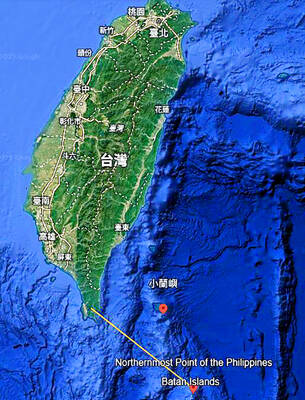
A US Marine Corps regiment equipped with Naval Strike Missiles (NSM) is set to participate in the upcoming Balikatan 25 exercise in the Luzon Strait, marking the system’s first-ever deployment in the Philippines. US and Philippine officials have separately confirmed that the Navy Marine Expeditionary Ship Interdiction System (NMESIS) — the mobile launch platform for the Naval Strike Missile — would take part in the joint exercise. The missiles are being deployed to “a strategic first island chain chokepoint” in the waters between Taiwan proper and the Philippines, US-based Naval News reported. “The Luzon Strait and Bashi Channel represent a critical access

Pope Francis is be laid to rest on Saturday after lying in state for three days in St Peter’s Basilica, where the faithful are expected to flock to pay their respects to history’s first Latin American pontiff. The cardinals met yesterday in the Vatican’s synod hall to chart the next steps before a conclave begins to choose Francis’ successor, as condolences poured in from around the world. According to current norms, the conclave must begin between May 5 and 10. The cardinals set the funeral for Saturday at 10am in St Peter’s Square, to be celebrated by the dean of the College